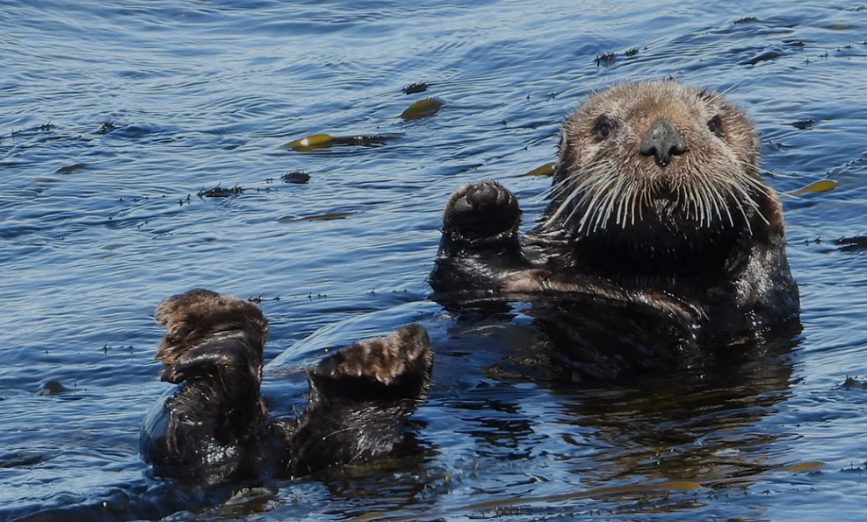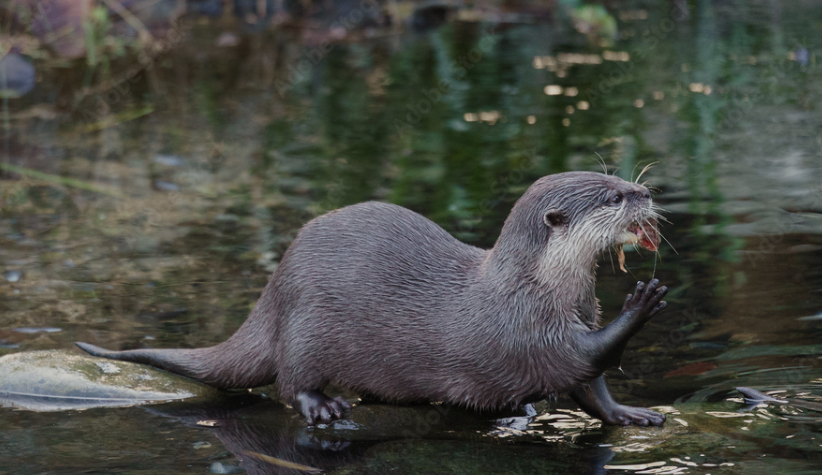
Otters are semi-aquatic mammals known for their playful behavior and remarkable swimming abilities. They belong to the family Mustelidae, which also includes weasels, badgers, and wolverines. With sleek bodies, webbed feet, and dense fur, they are perfectly adapted for life in and around water. Their streamlined form allows them to move gracefully while hunting and exploring rivers, lakes, and coastal habitats.
These animals are found on nearly every continent, from the icy waters of the North Pacific to the warm rivers of Africa and South America. Each species has its own preferred environment, with some living primarily in freshwater while others thrive along coastal areas. Their adaptability helps them occupy diverse habitats, though they all rely on access to clean water and abundant prey.
Food is central to their daily lives, and otters are skilled hunters. Fish make up the majority of their diet, but they also eat crabs, frogs, clams, and even small mammals or birds when opportunities arise. Their sharp teeth and agile movements allow them to catch prey quickly, often diving repeatedly until they’ve had their fill.
Social behavior varies across species. Some otters are solitary, preferring to hunt and live alone, while others are highly social, forming groups that work together for protection and play. Their playful actions, such as sliding down muddy banks or tossing objects, are not just for fun but also serve as practice for hunting and survival skills.
Otters are also known for their intelligence and use of tools. Certain species, for example, use rocks to crack open shellfish, displaying problem-solving skills rarely seen in other mammals. These behaviors demonstrate their adaptability and keen awareness of their environment.
Unfortunately, many otter species face threats from habitat loss, water pollution, and hunting for their fur. Conservation efforts around the world are focused on protecting their habitats and reducing human impacts on waterways. These measures are crucial, as otters play an important role in maintaining the balance of aquatic ecosystems.

Species of Otter
North American River Otter (Lontra canadensis)
This playful otter is found across rivers, lakes, marshes, and coastal areas of North America. With a sleek, muscular body, webbed feet, and thick waterproof fur, it is perfectly adapted for aquatic life. It feeds mainly on fish, amphibians, and crustaceans. Known for its energetic personality, it slides on mud or snow for fun, a behavior that has made it one of the most beloved otter species.
Sea Otter (Enhydra lutris)
Native to the northern Pacific Ocean, the sea otter is unique for spending nearly its entire life in the water. Unlike most otters, it does not rely on blubber for warmth but instead has the densest fur in the animal kingdom, with up to a million hairs per square inch. Sea otters are famous for using rocks as tools to crack open shellfish, showcasing remarkable intelligence and problem-solving skills.
Eurasian Otter (Lutra lutra)
One of the most widespread otters, the Eurasian otter ranges across Europe, Asia, and parts of North Africa. It inhabits rivers, lakes, and coastal regions, adapting to both freshwater and marine environments. This species is generally solitary, marking its territory with scent to deter rivals. Its diet is versatile, including fish, amphibians, and occasionally birds or small mammals.
Giant Otter (Pteronura brasiliensis)
Found in the rivers and wetlands of South America’s Amazon and Pantanal, the giant otter is the largest otter species, growing up to 6 feet long. It is highly social, living in family groups that hunt cooperatively. Known for its loud vocalizations, it communicates with a wide range of calls. Unfortunately, its population has declined due to habitat destruction and poaching, making it an endangered species.
Smooth-Coated Otter (Lutrogale perspicillata)
This medium-sized otter is found across South and Southeast Asia. Its fur is smoother and shorter than most otters, giving it a glossy appearance. Smooth-coated otters are social animals, often seen in family groups of up to 20 individuals. They are strong swimmers and highly effective hunters, preying on fish, crustaceans, and mollusks. They are increasingly threatened by wetland loss and pollution.
Spotted-Necked Otter (Hydrictis maculicollis)
Native to sub-Saharan Africa, the spotted-necked otter is smaller than many of its relatives and is easily recognized by the white blotches on its throat and chest. It prefers clear freshwater rivers and lakes where fish are abundant. Unlike some otters, it is more active during the day, diving with remarkable agility to catch prey. Habitat loss and water pollution are major challenges to its survival.
African Clawless Otter (Aonyx capensis)
This is one of the largest freshwater otters and is found throughout much of Africa. It is named for its partially clawless front feet, which are highly sensitive and allow it to feel for prey under rocks and mud. It primarily eats crabs, frogs, and fish. Unlike many otters, it spends significant time on land, moving between water bodies as seasons change.
Asian Small-Clawed Otter (Aonyx cinereus)
The smallest otter species, this otter inhabits rivers, wetlands, and mangrove swamps in South and Southeast Asia. Its reduced claws and highly dexterous fingers make it excellent at handling prey like crabs and shellfish. Asian small-clawed otters are very social, living in extended family groups and communicating with a wide variety of calls and whistles. They are often featured in conservation programs due to their vulnerability to habitat loss.
Marine Otter (Lontra felina)
Native to the rocky Pacific coasts of South America, the marine otter is one of the smallest marine mammals. Unlike the sea otter, which spends most of its time floating in the open ocean, the marine otter prefers turbulent coastal waters and rocky shorelines. It feeds on crustaceans, mollusks, and small fish, often foraging among seaweed and rocks. This species is shy and elusive, making it difficult to study, and is considered endangered due to habitat loss and hunting.
Neotropical Otter (Lontra longicaudis)
Found throughout Central and South America, the neotropical otter lives in rivers, streams, and wetlands, often in areas with dense vegetation. It is medium-sized and highly adaptable, with a diet that includes fish, amphibians, and crustaceans. Unlike the giant otter, it is generally solitary. Its range overlaps with other otter species, but it tends to thrive in regions where water quality is good and prey is abundant.
Hairy-Nosed Otter (Lutra sumatrana)
One of the rarest otters in the world, the hairy-nosed otter is found in Southeast Asia, though its population has drastically declined. It gets its name from the short hair covering its rhinarium (the nose pad). It inhabits wetlands, peat swamps, and rivers, relying on fish as its primary food source. Because of extensive habitat destruction and hunting, it is considered critically endangered.
Congo Clawless Otter (Aonyx congicus)
Closely related to the African clawless otter, the Congo clawless otter inhabits central Africa, particularly the Congo Basin. It prefers slow-moving rivers, swamps, and wetlands. It is distinguished by its lack of claws and its reliance on tactile sensitivity in its forepaws for foraging. Its diet includes amphibians, crabs, and small fish. Due to its reclusive nature, it remains one of the least studied otters.
Maxwell’s Otter (Lutrogale perspicillata maxwelli)
This is a subspecies of the smooth-coated otter found in the marshlands of Iraq. Named after the author Gavin Maxwell, who wrote about his experiences raising an otter in Iraq, it is specially adapted to life in shallow wetlands. Like its relatives, it is social and highly dependent on fish for food. Sadly, wetland drainage and habitat degradation in Iraq have greatly reduced its population.
Japanese River Otter (Lutra lutra whiteleyi)
Once native to Japan, this subspecies of the Eurasian otter was declared extinct in the 20th century. It lived in rivers and coastal regions and played an important role in Japanese folklore and culture. Overhunting, pollution, and habitat destruction were the main reasons for its decline. Though extinct, it is remembered as a symbol of conservation awareness in Japan.
Cape Clawless Otter (Aonyx capensis capensis)
A subspecies of the African clawless otter, it is widespread in southern Africa. It inhabits rivers, marshes, and coastal lagoons, feeding mainly on crabs, frogs, and fish. With partially clawless forepaws, it is excellent at feeling for prey in murky water. Unlike many otters, it spends significant time on land and is relatively adaptable, though it is threatened by water pollution and habitat disturbance.
Southern River Otter (Lontra provocax)
Endemic to southern Chile and Argentina, this species prefers freshwater rivers, lakes, and wetlands surrounded by dense vegetation. It is medium-sized, with thick fur that keeps it warm in cool southern climates. Its diet is dominated by fish and crustaceans. Once heavily hunted for its pelt, it now faces habitat loss and is considered endangered.